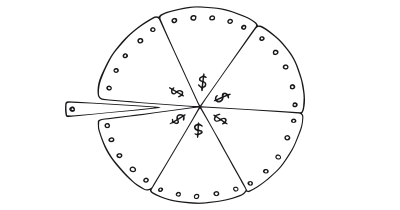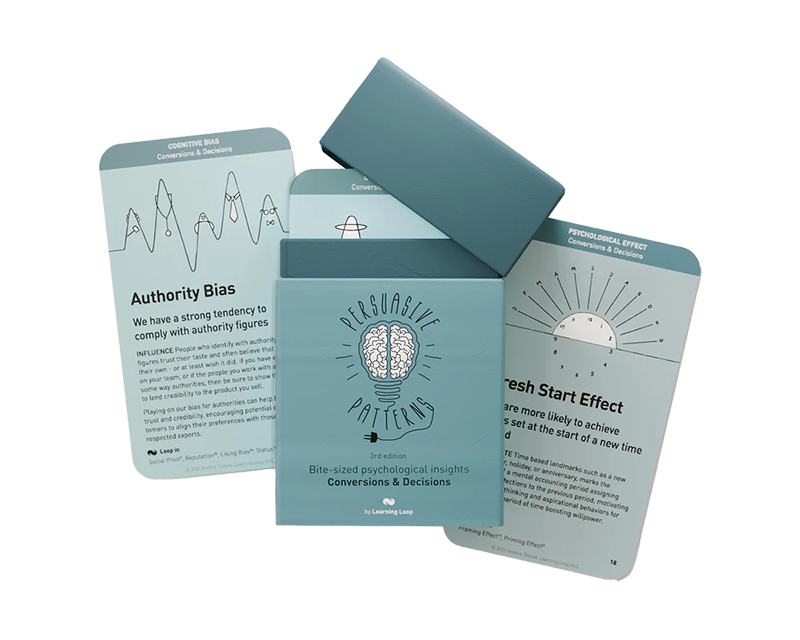Persuasive Patterns: Influence, Obligation
Authority Bias
We have a strong tendency to comply with authority figures

Authority Bias refers to the tendency of individuals to attribute greater accuracy or validity to the opinion of an authority figure, or an entity perceived as authoritative, and be more influenced by it.
Authority Bias plays a crucial role in shaping perceptions, beliefs, and actions. The core of this pattern lies in the human inclination to trust and follow those who are perceived as experts or leaders in a given domain. This trust stems from the belief that these figures possess superior knowledge or experience, making their endorsements or opinions more reliable. The potential of this bias is substantial, as businesses and platforms can harness it to guide user behavior, enhance credibility, and foster trust. However, it is vital that the use of this bias is rooted in genuine expertise and ethical considerations, ensuring that users are not misled.
Imagine walking into a bookstore, seeking a book to guide you on health and nutrition. While there are countless books on the shelf, one stands out with a sticker stating, “Recommended by Leading Nutritionists.” Even without diving into the details of the book, there’s an instinctual pull towards this particular book over others. The implicit trust placed in the expertise of leading professionals in the field influences the choice.
On an online shopping platform, a user is searching for a high-quality camera. Amidst the variety of options, there’s a section titled “Endorsed by Professional Photographers.” Within this section, several camera models are highlighted, each accompanied by a brief note from professional photographers explaining their preference. Even if these notes are succinct, their presence, rooted in authority and expertise, offers guidance and reassurance to potential buyers.
In both cases, the Authority Bias underscores the influence of expert opinions and recommendations on decision-making. It’s paramount for brands and digital platforms to ensure that such endorsements and recommendations are authentic and ethically sourced to maintain user trust.
The study
In the early 1960s, an experiment was conducted that demonstrated the profound influence of perceived authority on individual actions. Participants believed they were assisting in a learning experiment and were instructed by a researcher to administer increasingly intense electric shocks to another participant (who was, unbeknownst to them, an actor and not actually receiving shocks). Despite hearing the actor’s fabricated screams of pain, a significant portion of the participants continued to administer shocks when prompted by the authoritative figure, showcasing the intense pull of Authority Bias.
Milgram, S. (1963). Behavioral study of obedience. Journal of Abnormal and Social Psychology, 67(4), 371-378.
Authority Bias is rooted in our cognitive processing. It’s the tendency to attribute greater accuracy to the opinion of an authority figure and be more influenced by that opinion. This bias stems from our evolutionary predisposition to avoid conflict and harm, often deferring to those perceived as knowledgeable or powerful to ensure our safety and social cohesion.
People, who identify with authority figures, trust their taste and often believe that it fits their own – or at least they wish it did. If you have experts on your team, or if the people you work with are in some way authorities, then be sure to show them off to lend credibility to the product you sell.
We have a sense of duty to authority that makes us unable to defy their wishes. Authority help define the role we take upon ourselves and the roles we put on others. If an authority figure is seen as a teacher, we put on the learner or student role. If a policeman approaches us we take on the role as a suspect or informer.
We rarely agonize over the pros and cons that authority demands. With little or no conscious deliberation, we see information from a recognized authority as a valuable shortcut for deciding how to act in a situation. Authority positions speak of superior access to information and power, why it makes sense to comply with the wishes of properly constituted authorities.
Once a legitimate authority has given an order, subordinates stop thinking in the situation and start reacting. Often the appearance of authority is enough – we don’t always need to provide real authority. A uniform or famous face can do. We are often as vulnerable to the symbols of authority as to the substance.
Designing products with the Authority Bias
The symbols associated with authority, while sometimes subtle, have the power to significantly sway perceptions and decisions. Integrating these symbols into design or messaging strategies can amplify the credibility of a product or service, making it more enticing to potential users.
Titles and designations play a pivotal role in this context. For instance, if a product or service has received endorsement or has been developed by an individual with a PhD, emphasizing this fact can elevate its perceived value. The mere mention of such qualifications offers an immediate boost in credibility, making the offering more appealing to a discerning audience.
Similarly, the visual representation of professionals in attire corresponding to their field can evoke trust. A finance-oriented platform might benefit from imagery of individuals dressed in crisp business suits, suggesting a sense of formality and expertise. In contrast, a portal dedicated to medical advice or health products can instill confidence by showcasing professionals adorned in white lab coats, the universally recognized attire of the medical community.
Consistency in communication further solidifies authority. By regularly engaging the audience with insightful content – be it research findings, expert opinions, or industry trends—a brand can position itself as a thought leader and authoritative figure in its domain.
Drawing from real-world scenarios can further cement this concept. Consider online education platforms. Many such platforms prominently display the credentials of their instructors, degrees, publications, or years of industry experience, to attract potential students. Health and wellness websites often lean on testimonials or endorsements from medical professionals, emphasizing their professional titles and affiliations to gain users’ trust. Consulting firms, seeking to highlight their expertise, might showcase logos of past clients, especially if they’ve worked with renowned brands or industry leaders.
While symbols of authority can enhance credibility, relying solely on them without substantial expertise can lead to mistrust if users don’t find real value. Faking endorsements, using stock images without clear disclaimers, or exaggerating credentials can erode trust and harm your brand’s reputation in the long run. The goal is genuine trust-building, not mere manipulation.
While conveying authority is a powerful influencer, so is it to not to come off as overly boastful or arrogant. Any designs that play on the Authority Bias should subtly incorporate elements of authority without overwhelming the user or making grandiose claims. While authority can persuade, relatability can build trust, why finding the right balance between conveying expertise and not seeming distant or unapproachable is important.
Symbols of authority can vary significantly across cultures. What might be perceived as a mark of expertise or authority in one culture might not hold the same weight in another. Designers should be aware of cultural nuances and ensure their design resonates with the intended audience.
If you’re designing for multiple platforms or mediums, ensure that symbols and claims of authority are consistent across all of them. Inconsistent messaging can confuse users and diminish the perceived authority.
Ethical recommendations
The power of Authority Bias in shaping perceptions and driving behavior is undeniable. However, like all influential tools, it holds the potential for misuse. One of the primary concerns is the fabrication or exaggeration of authority. Brands or individuals might falsely claim endorsements, present fabricated credentials, or use symbols of authority without the substance behind them. Such practices can mislead users into making decisions that may not be in their best interest.
An over-reliance on authority can stifle critical thinking. By positioning a product, service, or idea as authoritative, users might be discouraged from seeking alternative viewpoints or conducting their own research. This can lead to an uninformed populace that merely adheres to perceived authority rather than making well-considered decisions.
To ensure that the use of Authority Bias remains ethical and user-centric, several best practices are recommended:
- Transparency and authenticity
Only use genuine symbols of authority. If presenting credentials, endorsements, or affiliations, ensure that they are legitimate and verifiable. Avoid exaggerating claims or using vague language that might mislead users about the extent of your authority or expertise. - Encourage critical thinking
While leveraging authority can be effective, it’s essential to encourage users to think critically. Offer them resources, alternative viewpoints, or avenues to conduct their own research. This not only respects their autonomy but also fosters an environment of informed decision-making. - Regularly review and update claims
The landscape of any industry or field can change over time. What was once considered authoritative might no longer hold that status. Regularly review and update any claims of authority to ensure they remain current and relevant. - Educate and inform
Rather than merely presenting yourself or your product as an authority, take the extra step to educate your users. Provide them with information, resources, and insights that reinforce your authoritative stance while also empowering them with knowledge.
Ethical utilization of the Authority Bias requires a delicate balance between asserting authority and respecting user autonomy, ensuring that trust is built on genuine expertise and transparency.
Real life Authority Bias examples
E-commerce Platforms
Many online shopping platforms highlight products that are “Doctor Recommended” or “Certified Organic” to assure customers of the product’s quality and safety.
Financial Tools
Investment platforms and apps often showcase advice or recommendations from reputed financial experts or analysts, enhancing user confidence in the platform’s offerings.
Educational Websites
Online courses or learning platforms may highlight their affiliation with top universities or feature endorsements from industry leaders to appeal to learners.
Trigger Questions
- Whose authority or expertise can I leverage to enhance the credibility of my product or message?
- How can I ensure that endorsements or affiliations presented are genuine, verifiable, and ethically sourced?
- What symbols or visual cues can I incorporate into the design to signify authority and expertise without being overly boastful?
- Are the symbols or claims of authority I'm using universally recognized, or do they need adjustments for different cultural contexts?
- How can I maintain consistent messaging about authority across all platforms and mediums to avoid confusing users?
- Beyond asserting authority, how can I educate and inform users to reinforce credibility and trust?
Pairings
Authority Bias + Social Proof
Combining the influence of recognized authority figures with the power of majority opinion can significantly enhance the persuasiveness of a message. For instance, a health app that cites a recommendation from a reputable medical institution and then showcases user testimonials or the number of downloads can significantly increase user trust and adoption.

We have a strong tendency to comply with authority figures

We assume the actions of others in new or unfamiliar situations
Authority Bias + Commitment & Consistency
When people see an authoritative figure endorse a particular behavior or product, they are more likely to commit to it. Once committed, due to the principle of consistency, they are likely to continue with that behavior or use the product consistently. An example could be a fitness program endorsed by a renowned athlete; users who commit to this program are more likely to stick to it in the long run.

We have a strong tendency to comply with authority figures

We want to appear consistent with our stated beliefs and prior actions
Authority Bias + Reputation
Authority figures often have established reputations, which can be harnessed to bolster the credibility of a product or service. A skincare product line co-developed with a respected dermatologist can be perceived as more trustworthy than one without such an endorsement.

We have a strong tendency to comply with authority figures

We adjust our personal behavior to reflect how we are perceived by others
Authority Bias + Storytelling
Combining a narrative with the endorsement or opinion of an authority figure can be a powerful tool. When a compelling story, perhaps of the authority figure’s personal experience or journey, is interwoven with the message, it becomes more relatable and memorable. For instance, a financial planning tool might share a story of a renowned economist who once struggled with managing personal finances but found solace and success using this specific tool.

We have a strong tendency to comply with authority figures

We engage, understand, and remember narratives better than facts alone
A brainstorming tool packed with tactics from psychology that will help you increase conversions and drive decisions. presented in a manner easily referenced and used as a brainstorming tool.
Get your deck!- Behavioral Study of Obedience by Milgram
- The Social Power of a Uniform by Bickman
- Milgram, S. (1963). Behavioral study of obedience. Journal of Abnormal and Social Psychology, 67(4), 371-378.
- Burger, J. M. (2009). Replicating Milgram: Would people still obey today? American Psychologist, 64(1), 1-11.
- Blass, T. (1999). The Milgram paradigm after 35 years: Some things we now know about obedience to authority. Journal of Applied Social Psychology, 29(5), 955-978.
- Milgram, S. (1974). Obedience to authority: An experimental view. Harper & Row.
- Cialdini, R. B. (2009). Influence: Science and practice (5th ed.). Allyn & Bacon.
- Cosmides, L., & Tooby, J. (1992). Cognitive adaptations for social exchange. In J. H. Barkow, L. Cosmides, & J. Tooby (Eds.), The adapted mind: Evolutionary psychology and the generation of culture (pp. 163-228). Oxford University Press.
- Moe, W. W. (2003). Buying, searching, or browsing: Differentiating between online shoppers using in-store navigational clickstream. Journal of Consumer Psychology, 13(1-2), 29-39.
- Barber, B. M., & Odean, T. (2001). The internet and the investor. Journal of Economic Perspectives, 15(1), 41-54.
- Agarwal, R., & Day, A. E. (1998). The impact of the Internet on economic education. The Journal of Economic Education, 29(2), 99-110.
- Fogg, B. J. (2003). Persuasive technology: Using computers to change what we think and do. Morgan Kaufmann Publishers.
- Chaiken, S. (1980). Heuristic versus systematic information processing and the use of source versus message cues in persuasion. Journal of Personality and Social Psychology, 39(5), 752.
- Cialdini, R. B., Trost, M. R., & Newsom, J. T. (1995). Preference for consistency: The development of a valid measure and the discovery of surprising behavioral implications. Journal of Personality and Social Psychology, 69(2), 318.
- Eagly, A. H., Wood, W., & Chaiken, S. (1978). Causal inferences about communicators and their effect on opinion change. Journal of Personality and Social Psychology, 36(4), 424.
- Green, M. C., & Brock, T. C. (2000). The role of transportation in the persuasiveness of public narratives. Journal of Personality and Social Psychology, 79(5), 701.
- Brown, R., & Hauenstein, N. M. A. (2005). Interrater agreement reconsidered: An alternative to the rwg indices. Organizational Research Methods, 8(2), 165-184.
- Bandura, A. (1977). Social learning theory. Prentice-Hall.
- French, J. R. P., & Raven, B. (1959). The bases of social power. In D. Cartwright (Ed.), Studies in social power (pp. 150-167). Institute for Social Research.
